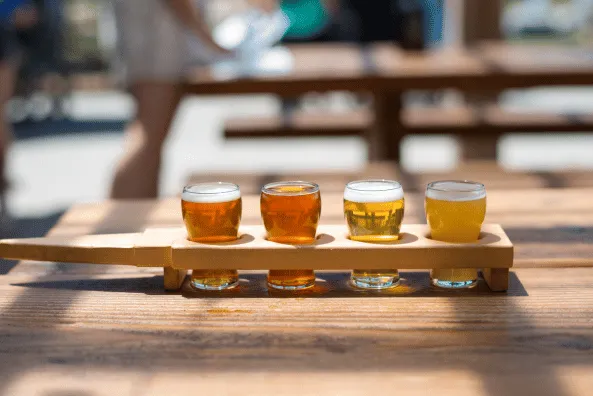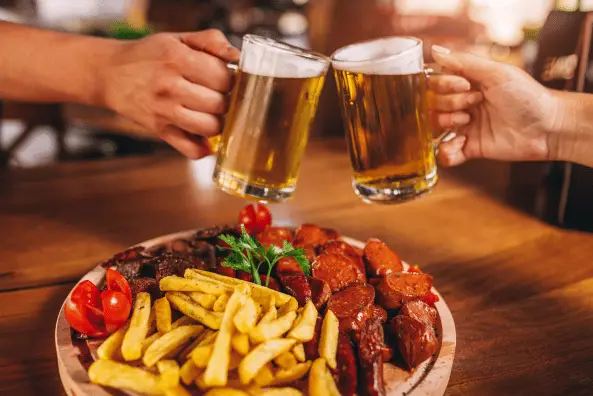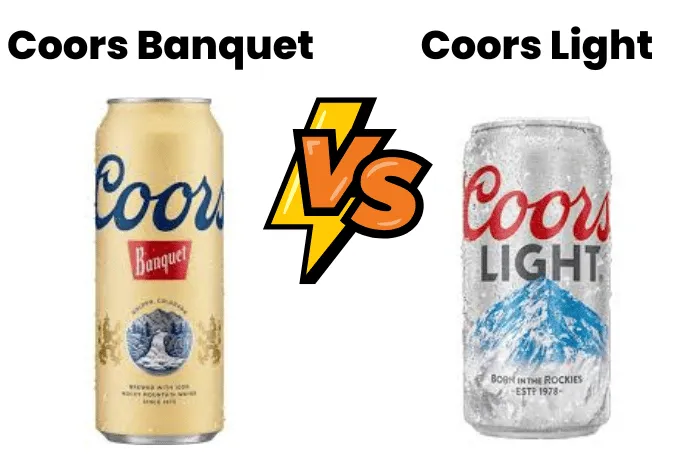You may have heard of Coors Banquet and Coors Light as a beer enthusiast. Many loyal beer drinkers across the United States love these two popular beers from the Coors Brewing Company. In this blog post, we will examine the differences between Coors Banquet and Coors Light and how they differ from other light American lagers like Bud Light and Miller Lite.
We’ll delve into how Coors Banquet was brewed in 1873 using Huppmann kettles and how it became a sought-after brand throughout Colorado before expanding to other states. We’ll also discuss how Coors Light was created in 1978 as a response to the growing popularity of light beers.
You’ll learn about the distinct flavour profile of each beer, with Coors Banquet being known for its full-bodied taste and smooth finish, while Coors Light is praised for its crispness and refreshing quality. We’ll also touch on why aluminium cans were introduced as packaging for both beers in 1959.
If you’re curious about all things related to these classic brews or simply want to expand your knowledge on popular beers in general, then keep reading!
Table of Contents:
- Origins and History
- Ingredients
- Fermentation & Brewing Process
- Flavor Profile & Mouthfeel
- Color
- Alcohol Content & International Bitterness Unit (IBU)
- What People Are Saying
- FAQs in Relation to Coors Banquet vs Coors Light
- Conclusion
Origins and History
Adolph Coors’ journey to founding the company is an inspiring story of hard work and determination. At fourteen, Adolph and his family relocated to America from Germany. He moved westward to Colorado, where he eventually started a brewery business known as Coors Brewing Company. Adolph worked tirelessly to perfect his brewing process, which resulted in what we now know as “Coors Banquet Beer.” This beer, first brewed in 1873, is a favorite among beer drinkers worldwide.
The nickname “Banquet Beer” originated from Clear Creek Canyon miners looking for a hearty beer after long days of laborious mining work. Moravian barley’s subtle sweetness and bitterness made it perfect for these workers, who called it “Banquet Beer” because it refreshed them after a long day. Many still call it “Coors Original” or “Bring Back Coors Banquet.”
Adolph Coors’ journey to founding the company is an exciting story that has been passed down for generations, and it’s incredible how his legacy still lives on today. As we discuss the ingredients used in brewing both beers, let us delve into what sets these two brews apart.
Coors Banquet vs Coors Light: Ingredients and IBU

Ingredients
Banquet Beer has a unique taste thanks to Rocky Mountain water, two-row Moravian barley malt, and corn syrup. This combination of ingredients gives Banquet Beer its rich, full-bodied taste with a slight sweetness on the finish.
Coors Light, on the other hand, uses two-row Moravian barley malt and is vegan-friendly. It retains some of its signature malty flavour characteristics associated with traditional American lager styles.
International Bitterness Unit (IBU)
The discrepancies between these two brews can be discerned by studying their alcoholic strength and International Bitterness Unit (IBU). Banquet has an ABV of 5%, while Light has 4%. In terms of IBU levels, Banquet clocks in at 11, whereas Light comes in slightly lower at 8, making it more approachable for those who don’t prefer the hoppy flavours often found in IPAs or pale ales.
Coors Banquet and Coors Light beers taste different due to their ingredients. Understanding these two beers’ fermentation processes and hop extract usage can help us understand their taste differences.
Coors Banquet vs Coors Light: Fermentation and Brewing
Fermentation
Both have different fermentation processes; however, lager yeast produces a light beer with a clean finish. The main difference between the two is the hop extract usage during brewing, giving them distinct flavour profiles.
The original Coors Banquet was created by Adolph Coor, who sought to create an authentic American beer that loyal beer drinkers across the country could enjoy. Adolph Coors’ 1873 beer, Coors Banquet, is known for its rich maltiness and smoothness. In contrast, Coors Light was introduced in 1978 as a lighter option to traditional lagers such as Miller Lite or Bud Light. It uses fewer hops than its counterpart and has a lighter colour due to fewer malts used during production. Thus, it has a crisp taste with citrusy notes, unlike Coors Banquet Beer, which tastes sweeter with caramelized sugar after each sip.
Brewing
Both beers are brewed using Huppmann kettles, which allow for consistent temperature control throughout the entire process while ensuring that no unwanted bacteria enter their products at any point during the production cycle. Aluminum cans preserve freshness better than glass bottles, so you can enjoy your favorite beverage anytime without worrying about skunking or oxidation.
Coors Banquet beer and light lager have different fermentation and brewing processes, but hop extract affects their flavors. Let’s compare Coors Banquet and Coors Light reviews to see how these differences affect mouthfeel and taste.
Coors Banquet vs Coors Light: Flavor Profile, Mouthfeel, and Color

Flavor Profile
Coors Banquet Beer and Coors Light are two completely different experiences regarding flavor profiles and mouthfeel. The light lager has a light floral flavor with a refreshing quality that is best enjoyed cold on hot summer days. On the other hand, the original Coors Banquet beer offers a heavier yet crisper taste that can vary depending on where you get your batch from.
Mouthfeel
The body of each beer also plays a vital role in its overall mouthfeel. For example, lighter beers like Coors Light tend to have thinner bodies, making them more watery than their counterparts. Conversely, full-bodied beers such as Coors Banquet provide fuller flavors with richer textures that linger longer in your mouth after drinking them.
Colour
There is a distinct difference when comparing the color of Coors Banquet and Coors Light. Coors Banquet has a golden hue that’s easy to drink, while Coors Light has a pale yellowish tint. This color difference can affect how people perceive each beer when drinking it. For example, many loyal beer drinkers may be drawn to the golden hues of Coor’s Original/Banquet Beer as they are associated with quality and craftsmanship. On the other hand, those who prefer light beers such as Bud Light or Miller Lite may find themselves drawn toward the lighter colors found in Coor’s Light.
Finally, when it comes down to what people are saying about these two iconic American brews – loyal beer drinkers love them both. They appreciate their refreshing taste and easy drinkability whether they’re at home enjoying one with friends or at a local bar celebrating special occasions such as birthdays and anniversaries.
What People Are Saying About Coors Banquet vs Coors Light
When it comes to customer reviews, Coors Banquet and Coors Light are two of the most popular beers among loyal beer drinkers. On different platforms, people have given high praise for both varieties of Coors Beer. Many customers appreciate the classic American lager taste that comes from a cold glass of Coors Banquet, while others enjoy the crisp refreshing taste that comes from a cold glass of Coors Light.
Regional Popularity
In terms of regional popularity, Coors Beer is a hit among many fans in the Midwest and Rocky Mountain regions due to its close proximity to where Adolph Coor’s brewery was founded back in 1873. People from this area often refer to their favorite beer as “Banquet Beer” or “Original”. On the other hand, Bud Light or Miller Lite are more favored by folks living in Texas, California and Florida since they can get it in aluminum cans.
Overall, these two brews provide a range of experiences for all beer lovers – from the smooth taste of a light lager to more complex flavors with malt and hop accents. These days, these brews are highly sought after by consumers.
FAQs in Relation to Coors Banquet vs Coors Light
Is there a difference between Coors Light and Coors Banquet?
Yes, there is a difference between Coors Light and Coors Banquet. The same company produces both beers, but they have distinct differences in taste and production. Coors Light is brewed with light-colored malts for a crisp flavor low in calories and carbs. However, Coors Banquet uses two-row barley malt for a fuller flavor and slightly higher alcohol content. Ultimately, it’s a matter of individual taste, as both brews have distinct flavor characteristics.
What is so great about Coors Banquet?
Coors Banquet is an iconic American beer that has been brewed since 1873. It’s a classic, light-bodied lager with a distinctively smooth taste and subtle hop character. The balance of sweet malt and crisp hops makes it incredibly drinkable. Its moderate ABV makes it suitable for any occasion, and its low price means everyone can enjoy it. Coors Banquet is an excellent choice for those looking to experience a piece of history in their glass.
Why was Coors Banquet illegal?
Coors Banquet was illegal from 1916 to 1933 due to the Prohibition Act. The Prohibition Act disallowed any manufacturing, transporting, importing, and selling of alcoholic drinks within the US. Coors had been producing beer since 1873, but they were not allowed to do so legally during this period. This ban was only lifted when the 21st Amendment repealed prohibition in 1933.
What is the deal with Coors Banquet?
Coors Banquet is a classic American lager beer from the Coors Brewing Company. It has been around since 1873 and was first introduced as a “banquet beer” for miners in Colorado. This malty, amber-colored lager has 5% ABV and a delicious blend of corn sweetness, biscuit maltiness, and herbal hop notes. Its crisp finish makes it perfect for pairing with grilled meats or savory snacks. Coors Banquet is a fine selection for those wanting to savor an effortless brew with some classic taste.
Conclusion
In conclusion, Coors Banquet and Coors Light differ in origins, history, ingredients used to brew them, fermentation, and the brewing process employed by the brewers. Furthermore, they also differ in flavor profile, mouthfeel, color, alcohol content, and International Bitterness Unit (IBU). Ultimately, it is essential to recognize that each type of beer offers its distinct characteristics and should be weighed carefully when selecting between Coors Banquet and Coors Light. Ultimately, “coors banquet vs coors light” will come down to personal preference, so why not try both beers out before deciding?
Discover the difference between Coors Banquet and Coors Light with our comprehensive reviews, guides to beer equipment, subscription services, and beer making tips. Join us now for all your craft brew needs!
Also Visit: Comparing Brown Ale vs Stout: History, Taste, and More

